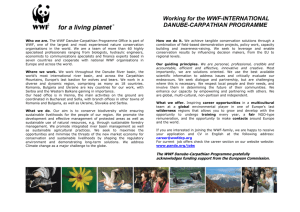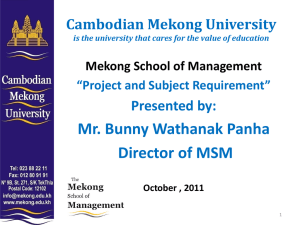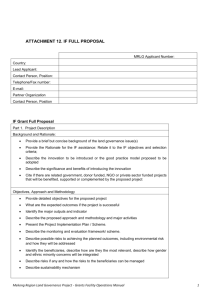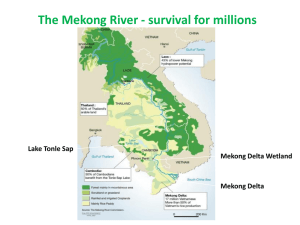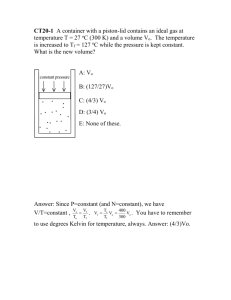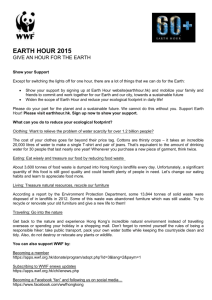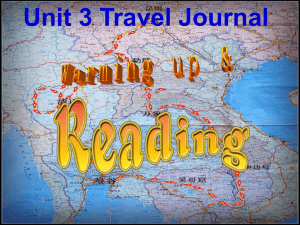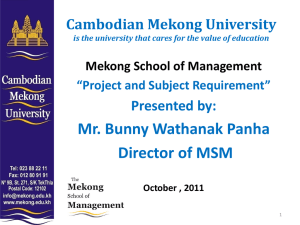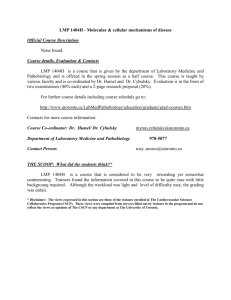Mekong
advertisement
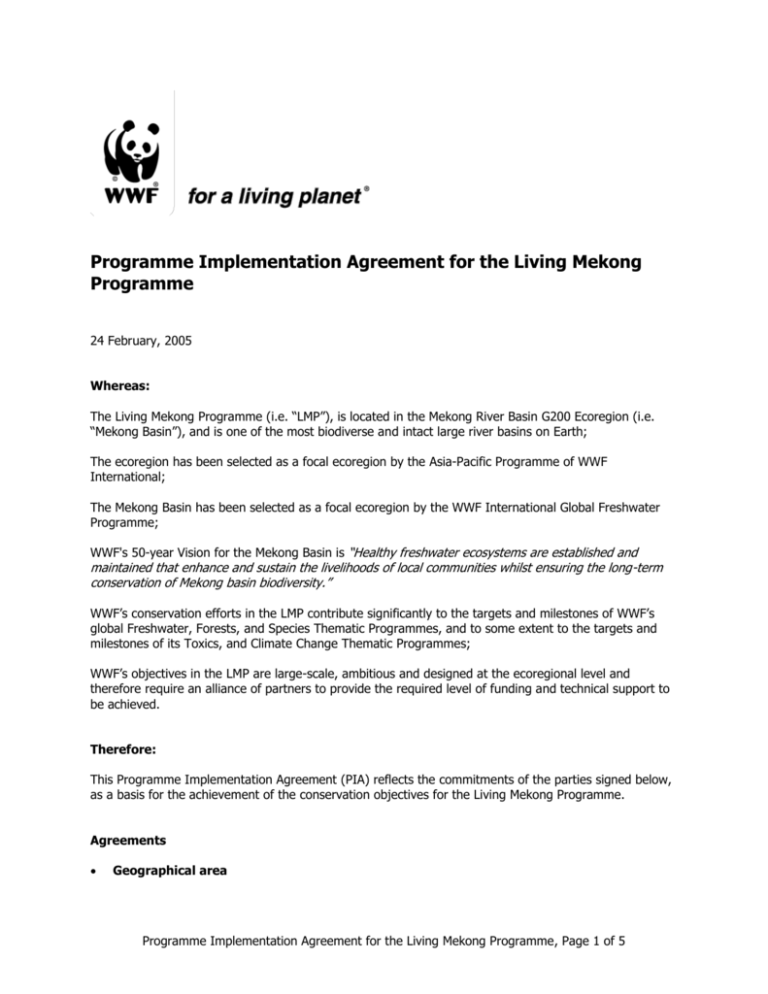
Programme Implementation Agreement for the Living Mekong Programme 24 February, 2005 Whereas: The Living Mekong Programme (i.e. “LMP”), is located in the Mekong River Basin G200 Ecoregion (i.e. “Mekong Basin”), and is one of the most biodiverse and intact large river basins on Earth; The ecoregion has been selected as a focal ecoregion by the Asia-Pacific Programme of WWF International; The Mekong Basin has been selected as a focal ecoregion by the WWF International Global Freshwater Programme; WWF's 50-year Vision for the Mekong Basin is “Healthy freshwater ecosystems are established and maintained that enhance and sustain the livelihoods of local communities whilst ensuring the long-term conservation of Mekong basin biodiversity.” WWF’s conservation efforts in the LMP contribute significantly to the targets and milestones of WWF’s global Freshwater, Forests, and Species Thematic Programmes, and to some extent to the targets and milestones of its Toxics, and Climate Change Thematic Programmes; WWF’s objectives in the LMP are large-scale, ambitious and designed at the ecoregional level and therefore require an alliance of partners to provide the required level of funding and technical support to be achieved. Therefore: This Programme Implementation Agreement (PIA) reflects the commitments of the parties signed below, as a basis for the achievement of the conservation objectives for the Living Mekong Programme. Agreements Geographical area Programme Implementation Agreement for the Living Mekong Programme, Page 1 of 5 The geographical area of concern is the Mekong Basin which includes parts of the following six countries: Cambodia, China, Lao PDR, Myanmar, Thailand, and Vietnam, and encompasses approximately 800,000 square kilometers. It overlays all or parts of the following seven G200 ecoregions: No. 144 - Mekong River; No. 22 - Northern Indochina Subtropical Moist Forests; No. 25 Annamite Range Moist Forests (or Greater Annamites); No. 35 Cardamom Mountains Moist Forests, No. 54 - Indochina Dry Forests (or Lower Mekong Dry Forests); No. 80 - Hengduan Shan Coniferous Forests; and No.110 - Tibetan Plateau Steppe. Time and scope This Agreement covers six years, 2005-2010, and makes specific reference to the WWF Living Mekong Programme Conservation Plan and Business Plan (2004-2010). The agreement will be reviewed every three years by the parties. Programmatic Strategy In order to achieve the 50-year vision for the Mekong Basin, WWF will focus its efforts over the next six years on river basin management; conserving freshwater ecosystems, processes, habitats and species; sustainable resource management; awareness raising and capacity building; and sustainable energy. These key elements are described in more detail in the WWF Living Mekong Programme Conservation Plan implementation matrix, which is attached to this agreement (Annex I). This matrix will be reviewed annually. Financing Strategy Funding for the LMP has been between US$ 39,000-189,000 a year during the period FY2002-FY2004. Secured funds for FY05-FY10 total US$ 1 million. In order to implement the LMP Conservation Plan for FY05-10, an annual investment of approximately $2 million is required. Gaps between the three-year funding requirement and funds secured are detailed in Annex I. It is the intention of the Parties to secure the funds needed for the implementation of the Programme. The Advisory Team (see Management Strategy below) will further develop and implement a fundraising plan to fill critical gaps. This fundraising plan will be reviewed and updated by the Advisory Team on an annual basis. Programme Implementation Agreement for the Living Mekong Programme, Page 2 of 5 Management Strategy To facilitate the management of the LMP a Steering group and an Advisory team will be constituted. The Steering group will: Comprise the LMP Manager, the objective managers and the Representative (chair) Meet formally twice a year Review detailed progress towards the targets and milestones defined in the LMP Conservation Plan, Implement adaptative management Adapt workplan and develop new activities Update Annex I, and the Business Plan, based on the recommendations and information provided by the Advisory Team. Propose any changes in PIA membership to the Advisory Team Present progress and management decision annually to advisory team The Advisory Team will: Comprise representatives of all PIA members, as nominated by the PIA member offices Meet annually formally (physically or remotely) Provide technical guidance but not binding line management Review overall progress and management decision towards the targets and milestones defined in the LMP Conservation Plan, Validate changes to PIA membership Provide updated commitments for Annex I. Either group can meet informally as needed if needs or opportunity occurs. The LMP Coordinator will develop the agenda and content for the Advisory Team meeting in consultation with the LMP Steering group (as defined in the Business Plan) and will serve as Secretary to the Advisory Team. The Parties will arrange for a formal mid-term evaluation of the LMP in 2008 Roles and responsibilities of the parties WWF-Indochina PO, Thailand PO and China PO will implement conservation activities in their territories as agreed in the attached Annex I. All of the Parties will comply with WWF Network Standards for planning and reporting, including the timely preparation of semi-annual technical and financial reports on all projects; these reports will be uploaded to the WWF-International Project Database. An annual progress report on implementation of the LMP Conservation Plan will be prepared by the LMP Coordinator and distributed to all Parties before the annual Advisory Team meeting. The Global Monitoring System for Ecoregion Action Programmes (GMS-EAP) report can be used as a basis for the annual Advisory Team report. All Parties will also keep the LMP Coordinator informed about their activities relevant to the LMP through periodic informal updates and will produce an annual summary in preparation for the Advisory Team meeting. NOs should actively promote using the standard WWF technical and financial reporting formats to GAAs to avoid extra work. Programme Implementation Agreement for the Living Mekong Programme, Page 3 of 5 Country specific implementation that contributes to the LMP strategy will be organized through a service contract arrangement between the LMP and the relevant country director(s). This service contract will clarify the roles and responsibilities for each LMP project at the country level. The LMP Coordinator will serve as an information and communications hub for the LMP. The Coordinator will also serve as the focal point for Network inquiries about the LMP. The LMP Coordinator will report to the Country Representative of ICPO, TPO and CPO. All the Parties have indicated commitments and expressions of interest in different forms of support as specified in Annex I. They will also explore opportunities for new sources of funding. Mekong Basin Big Wins The Mekong team and PIA partners have developed two Big Win projects to support important parts of the LMP strategy. The two Big Win projects, centered on the July 2005 Greater Mekong Subregion (GMS) Summit led by the Asian Development bank (ADB) aim to achieve the following: 1. The countries of the Mekong Basin commit to apply the principle of “Scenarios for Hydropower Development in the Mekong Basin” and ADB supports the implementation of the agreement by the July 2005 GMS Summit (date might be revised). 2. The GMS Ministerial Declaration on the Environment coming out of the July 2005 Summit includes commitments by the 6 GMS countries to protect manage and restore endemic and endangered species, critical habitats and ecosystem functions throughout the Mekong Basin, by developing effective networks of protected areas and systems of corridors managed for maintenance of biodiversity, in all basin countries. Status of this agreement This document is a non-contractual statement of the agreements reached among the Parties signed below. By their signatures, the representatives of the offices and programmes confirm their concordance with the content of this Programme Implementation Agreement and its Annexes. Programme Implementation Agreement for the Living Mekong Programme, Page 4 of 5 Signatories On Tuesday 1st March 2005, in Manesar, India, the undersigned as representatives of their respective programmes (listed in alphabetical order) agree with the terms and conditions outlined in this Agreement WWF Germany National Office WWF International Freshwater Global Thematic Programme WWF Indochina Programme Office WWF Switzerland National Office WWF International Asia Pacific Regional Programme WWF Thailand Programme Office WWF International Forests for Life Global Thematic Programme WWF United States National Office Programme Implementation Agreement for the Living Mekong Programme, Page 5 of 5
